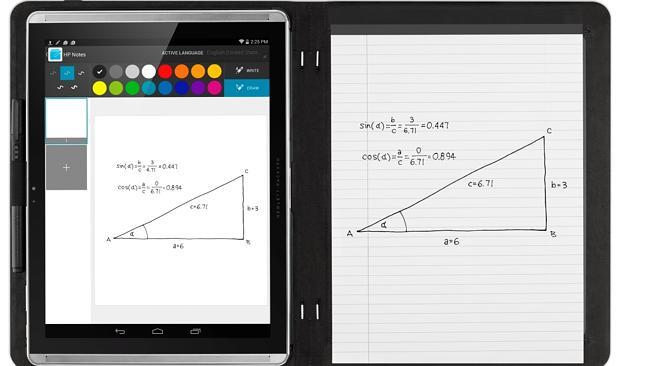HP Pro Slate 8: take note, smartpen is making a bold display
If you own a device like a Galaxy Note then you probably already know how useful a stylus can be.

If you own a device like a Galaxy Note then you probably already know how useful a stylus can be. As fluid as the pen-on-screen experience has become over the last couple of years, none feel as natural as using good old-fashioned pen and paper.
There are accessories that you can buy like the Livescribe 3 smartpen, which allow you to write on specialist paper, which is then digitised to your mobile device for easier storage. HP is taking things a step further by attempting to combine the functionality of both aforementioned devices into a dedicated Android tablet with the HP Pro Slate 8.
The HP Pro Slate 8 looks slick for a tablet that’s geared towards the enterprise with its sleek design that mimics Apple’s iPad mini in display resolution (7.9-inch 2048 x 1536), weight (350 grams), size and all metal build. At 7.99mm, the Slate 8 is slightly thicker but has a thinner profile than most other metal-clad tablets on the market.
It also boasts a pair of front-firing speakers, which are loud, distortion-free and rich sounding.
The Slate 8 comes with what HP calls the Duet Pen, which as the name suggests works both as a stylus and a regular black-ink pen where the tip of the pen can be pulled out and flipped around to accommodate either writing on screen or paper.
Writing with the Duet Pen on any nearby notepad will mirror your scribbles on the tablet with minimal delay. The Slate Pro triangulates the stylus’ position and vertical movement using sound waves that are picked up by the microphones dotted around the tablet. This digital pen technology actually comes from chipmaker Qualcomm and is different to something like the Livescribe, which uses a infrared camera stored in the tip of the pen to capture your handwritten scribbles.
Since there’s no need for a camera, HP has been able to keep the Duet Pen looking much more like a traditional pen with thinner and lighter construction than the comparatively chunkier Livescribe 3 smartpen. It’s easier to grip and easier to write with.
While the pen tracking can technically work with any piece of paper, there are some caveats.
Firstly, you must ensure both the paper and tablet are aligned and that the paper is positioned on the left and directly next to the device. If you randomly pick up a piece of paper and start writing the tablet won’t capture anything. HP sells the Paper Folio case accessory ($69 sold separately) into which you can slide in a regular A5 lined notepaper while the tablet slots into its protective shell on the right. With the Folio case it’s less fiddly as there’s no need to worry about the correct positioning of the pad. Before you write, you must create a notebook in “capture” mode within the HP Notes app.
But the mapping of the piece of paper to the digital version in the app is not exactly one-to-one, which means that anything we wrote on the bottom line of each page during testing wasn’t captured. Nor were words stretching to the end of each line on the physical page captured digitally.
In general, the tablet does a decent job of mirroring handwriting but the tracking can be inconsistent. Unlike the Livescribe, the Duet Pen and Slate tablet combo won’t detect when you start writing on the next page, requiring you to manually first add a new page in the HP notes app before you can recommence writing.
Another oddity is that the tablet will stop tracking your handwriting whenever the screen goes to sleep. The auto-lock must be disabled and the screen has to stay on while using the pen. That has a big impact on the battery life. Switching to writing on the tablet directly is pretty accurate and comparable to the pen experience on the Surface Pro. But the HP Notes app lacks basic features like the option to convert onscreen scribbles to clean text. Fortunately, there are dozens of other apps on the Google Play Store that you can use, but if you want to capture what you write on paper you are tied to the HP Notes app.
As one of the few devices on the market to offer a pen that works on both a tablet and regular paper, the HP Pro Slate 8 holds a lot of appeal for those who want a digital copy of their notes.
But at a starting price of $649 plus another $69 for the Folio case, it is pricey, especially if you already own a tablet. The Slate 8 is hard to recommend when the Livescribe 3 retails for a quarter of the price, works with your existing iPad or Android tablet and, crucially, does a much more accurate job of digitising your handwritten notes from paper.


